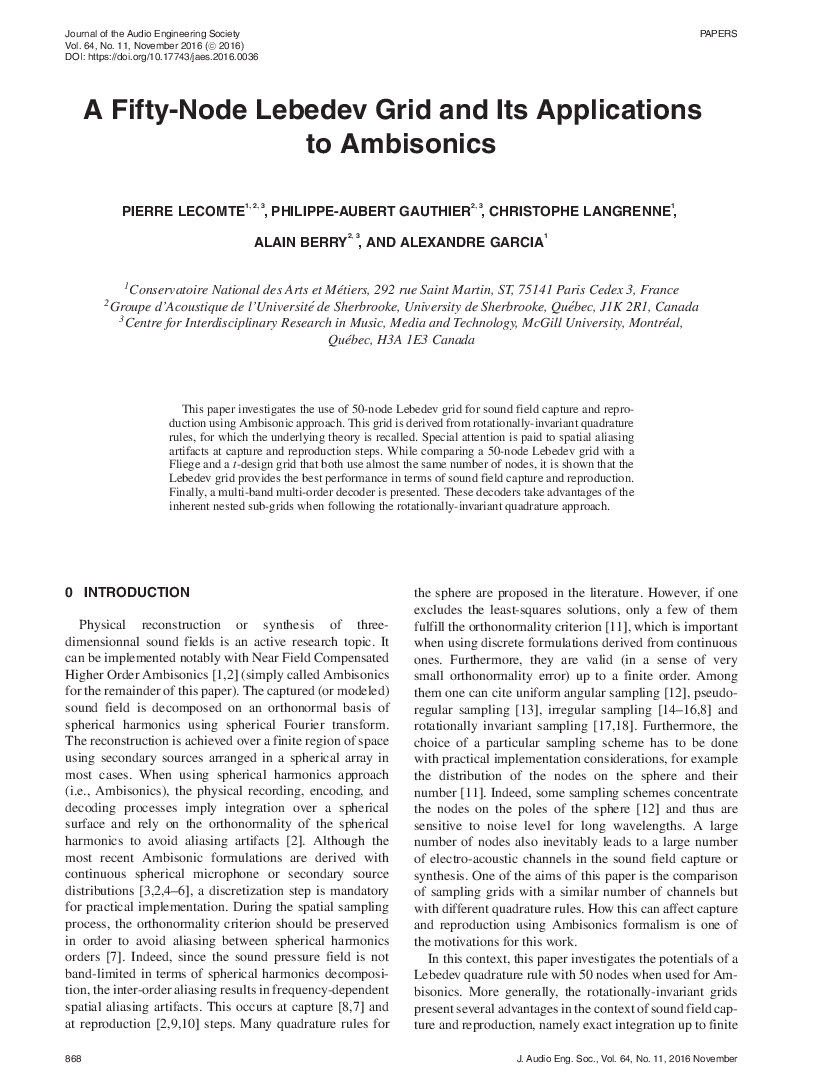Home / Publications / E-library page
You are currently logged in as an
Institutional Subscriber.
If you would like to logout,
please click on the button below.
Home / Publications / E-library page
Only AES members and Institutional Journal Subscribers can download
Physical reconstruction or synthesis of three-dimensional sound fields can be implemented with Near Field Compensated Higher Order Ambisonics. This paper investigates the use of a fifty-node Lebedev grid, which is derived from rotationally-invariant quadrature rules. Special attention is paid to spatial aliasing artifacts at the capture and reproduction steps. While comparing a fifty-node Lebedev grid with a Fliege and a t-design grid that both use almost the same number of nodes, it is shown that the Lebedev grid provides the best performance in terms of sound field capture and reproduction. Finally, a multiband multiorder decoder is presented. These decoders take advantage of the inherent nested subgrids when following the rotationally-invariant quadrature approach. The importance of orthonormality of the spherical harmonics was highlighted in a context of physical encoding or reconstruction of a sound field with the Ambisonics approach. Simulation results are provided for the case of a three-band decoder using the three grids contained in the Lebedev grid. It was found that a multifrequency sound field can be reproduced accurately in the sweet-spot by using a combination of low-order decoder for low frequency and higher-order decoder for higher frequency.
Author (s): Lecomte, Pierre; Gauthier, Philippe-Aubert; Langrenne, Christophe; Berry, Alain; Garcia, Alexandre
Affiliation:
Conservatoire National des Arts et Métiers, Paris, France; Groupe d’Acoustique de l’Université de Sherbrooke, University de Sherbrooke, Québec, Canada; Centre for Interdisciplinary Research in Music, Media and Technology, McGill University, Montréal, Québec, Canada
(See document for exact affiliation information.)
Publication Date:
2016-11-06
Import into BibTeX
Permalink: https://aes2.org/publications/elibrary-page/?id=18524
(416KB)
Click to purchase paper as a non-member or login as an AES member. If your company or school subscribes to the E-Library then switch to the institutional version. If you are not an AES member Join the AES. If you need to check your member status, login to the Member Portal.

Lecomte, Pierre; Gauthier, Philippe-Aubert; Langrenne, Christophe; Berry, Alain; Garcia, Alexandre; 2016; A Fifty-Node Lebedev Grid And Its Applications To Ambisonics [PDF]; Conservatoire National des Arts et Métiers, Paris, France; Groupe d’Acoustique de l’Université de Sherbrooke, University de Sherbrooke, Québec, Canada; Centre for Interdisciplinary Research in Music, Media and Technology, McGill University, Montréal, Québec, Canada; Paper ; Available from: https://aes2.org/publications/elibrary-page/?id=18524
Lecomte, Pierre; Gauthier, Philippe-Aubert; Langrenne, Christophe; Berry, Alain; Garcia, Alexandre; A Fifty-Node Lebedev Grid And Its Applications To Ambisonics [PDF]; Conservatoire National des Arts et Métiers, Paris, France; Groupe d’Acoustique de l’Université de Sherbrooke, University de Sherbrooke, Québec, Canada; Centre for Interdisciplinary Research in Music, Media and Technology, McGill University, Montréal, Québec, Canada; Paper ; 2016 Available: https://aes2.org/publications/elibrary-page/?id=18524
@article{lecomte2016a,
author={lecomte pierre and gauthier philippe-aubert and langrenne christophe and berry alain and garcia alexandre},
journal={journal of the audio engineering society},
title={a fifty-node lebedev grid and its applications to ambisonics},
year={2016},
volume={64},
issue={11},
pages={868-881},
month={november},}
TY – paper
TI – A Fifty-Node Lebedev Grid And Its Applications To Ambisonics
SP – 868 EP – 881
AU – Lecomte, Pierre
AU – Gauthier, Philippe-Aubert
AU – Langrenne, Christophe
AU – Berry, Alain
AU – Garcia, Alexandre
PY – 2016
JO – Journal of the Audio Engineering Society
VO – 64
IS – 11
Y1 – November 2016